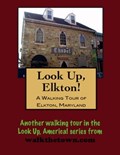There is no better way to see America than on foot. And there is no better way to appreciate what you are looking at than with a walking tour. This walking tour of Elkton, Maryland is ready to explore when you are. Each walking tour describes historical, architectural landmarks, cultural sites and ecclesiastic touchstones and provides step-by-step directions.
Every tour also includes a quick primer on identifying architectural styles seen on American streets.
Once known as Head of Elk, named by Captain John Smith, Elkton sits at the northern headwaters of Chesapeake Bay. Its fortuitous location placed the settlement squarely on the principle north-south roadway in Colonial America. Its strategic advantages caused Head of Elk to be chosen by the British as the starting point for their attack of Philadelphia during the American Revolution. On August 27, 1777, three hundred ships carrying over 15,000 soldiers appeared in the Elk River. The British landed unopposed, stayed awhile in Head of Elk and marched to the nation's capital which they occupied after pitched battles at Brandywine and Germantown. Four years later, the Marquis de Lafayette embarked his troops here in his pursuit of traitor Benedict Arnold. He was followed by George Washington who was marching his forces overland to ultimate victory at Yorktown, Virginia.
Elkton preceded Baltimore in the development of the flour-packing industry and was hailed by 1807 as an important wheat market, with trade having attained a level of 250,000 bushels per year. After the War of 1812, packet lines continued to run between Elkton and Baltimore, and the New Castle and Frenchtown Railroad that began in 1832 further increased Elkton's importance as a transportation center. Numerous mills were established on the Elk River, evidenced by still-surviving millraces, and the town thrived. Prosperity waned for several decades in the financially precarious times of the 1830s but the post Civil-War years brought new industries, including pulp mills, machine shops, fertilizer plants and canneries to the town, stimulating housing construction in the late 1800s. It was Elkton's Golden Age.
Elkton achieved national notoriety in the the 1920s and 1930s when northern states began to pass more restrictive marriage laws. Maryland did not and a number of border towns became known as places to get married quickly and without many restrictions, or "Gretna Greens." Elkton, being the northeastern most county seat in Maryland - and thus closer to Philadelphia, New York, and New England - was particularly popular. It was "the elopement capital of the East Coast" and thousands of marriages were performed there each year. Some of the celebrities who got married in Elkton included actresses Joan Fontaine and Debbie Reynolds, singer Martha Raye, political figures John and Martha Mitchell, baseball great Willie Mays, and televangelist Pat Robertson. Even after the quickie-marriage was eliminated when the state passed a 48-hour waiting period in 1938, Elkton continued to be a place to marry, and especially elope.
Our walking tour will start in the historic center of the old Head of Elk, only a few steps away from a marrying chapel...

